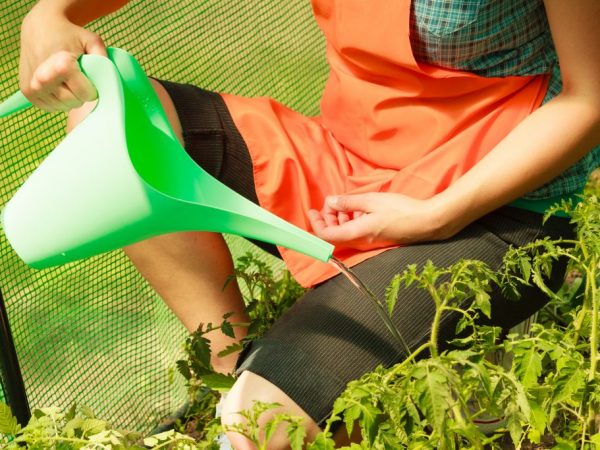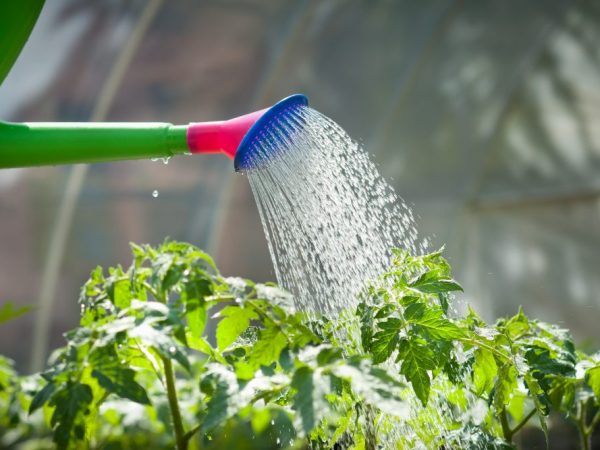Rules for watering tomatoes with soda
Watering tomatoes with soda is one of the types of non-standard feeding of vegetable crops, widely used by summer residents in their personal plots. Gardeners begin to spray future harvests of tomatoes and cucumbers with soda solutions already at the early stages of development and growth, before flowering.

Rules for watering tomatoes with soda
The benefits of soda for vegetables
Affordable and cheap bait in the form of a soda solution brings significant benefits when growing vegetables in a summer cottage. Among the main positive qualities of products are:
- antiviral and antibacterial action, which allows you to fight pests and infectious plant diseases in time,
- plant resilience properties that resist damage to the leaves of tomatoes and cucumbers, thereby preventing premature wilting and dropping.
Using soda mixtures when growing tomatoes in a summer cottage, you can achieve effective positive results, including:
- increase the quantitative characteristics of seedling germination, the quality of tomato ovaries, the yield of vegetable crops,
- improve the external characteristics of vegetables and leafy parts of plants, their taste,
- to reduce the threshold of plant morbidity with infectious bacterial and fungal diseases,
- increase the duration of the fruiting period of the plant, scare away harmful insects from the tomato bushes.
Spraying tomatoes with solutions with soda allows you to create an environment that repels pests and at the same time does not directly harm the vegetable crop and the future tomato harvest. The use of soda solutions deoxidizes the soil layer, lowering the acidity.
Application of solutions at different stages of plant development
When growing a vegetable crop in a summer cottage, feeding tomatoes with baking soda is necessary at different stages of growth and development of a vegetable crop.
Seed preparation
It is possible to ensure a good harvest in the garden only when high-quality seed is planted. You can prepare tomato seeds for planting by soaking in a solution. To do this, they need to be processed during the day in an aqueous solution with 1% baking soda content in it.
When soaking seeds in bicarbonate, the period of their stay in it should not be exceeded, so as not to lower the quality characteristics of the seed.
After planting seedlings
Immediately after planting seedlings in soil, it is recommended to spray the bushes and water them at the root. This will provide reliable protection of the vegetable crop against the appearance of pests, fungi and bacteria and preserve the future tomato harvest. To feed and water the bushes with baking soda, prepare a solution with a concentration of 5%, spray and water them no more than 1 time per week.
At the stage of intensive development
To increase the intensity of the development of vegetable crops, soda solutions are used as fertilizer. Spraying and watering tomatoes gives them healthy, full growth and increases yields. For this purpose, a 1% soda solution is made, with which the ridges with tomato bushes are watered in the evening, no more than once a week, while observing how the plants react to fertilization. Over-saturation of the soil and burns on foliage and stems are a sign of increasing the interval between sprays.

Soda solution increases plant productivity
Watering beds with tomatoes at the stage of intensive development in hot weather is not used to avoid burns to the plant.
When primary signs of the presence of insects or fungal diseases appear, tomato bushes are sprayed in the process of feeding, without waiting for the time of the next watering, starting the procedure immediately.
After ovary
Root watering with a 3.5% soda solution and foliar watering by spraying on the leaves with a 0.5% composition will help make vegetables juicy and tasty.
Pest and disease control
In addition to the positive effect when growing tomatoes at different stages of plant development, the soda composition is beneficial in maintaining the health of tomato bushes, protecting them from pest attacks and preventing the spread of fungal and bacterial diseases.
Powdery mildew
Powdery mildew baking soda is well established as an antibacterial agent. For spraying, a mixture is prepared in the specified proportions:
- baking soda - 50 g,
- crushed laundry soap - 40 g,
- water - 10 liters.
All components are mixed until they are completely dissolved. tomatoes are sprayed with a frequency of more than once every 7-10 days.
Aphids, spider mites
To combat aphids and spider mites, 75 g of soda powder is diluted with 10 liters of water. The prepared solution is sprayed on the leaves and stems of the plant once a week.
Phytophthora
Against late blight, tomatoes are sprayed with a soda mixture mixed with vegetable oil and laundry soap in a proportion of 2 tbsp. l. soda powder for 1 tbsp. l. oil and a glass of soap. All ingredients are diluted in a liter of water. Processing is carried out in dry weather conditions in the morning or in the evening, the interval between approaches is 7 days.
Fighting yellow foliage
The yellowing of the leaves in tomatoes is the primary sign of wilting of the foliage and their subsequent fall.
Timely processing of tomato bushes with a soda composition will extend the fruiting period of a vegetable crop. Tomatoes are treated with a soda mixture with a low concentration three times in one gardening season:
- twice in the middle of the summer period - at the beginning and at the end of July,
- one-time closer to mid-August.
For a slightly concentrated composition used in root watering of tomato bushes, 1 tbsp is enough. l. powder in a 10 liter bucket of water.
Additionally, such a soda mixture can be sprayed on foliage for prophylactic purposes against pests. Such treatment will allow the plant to retain strength for a longer fruiting period.


